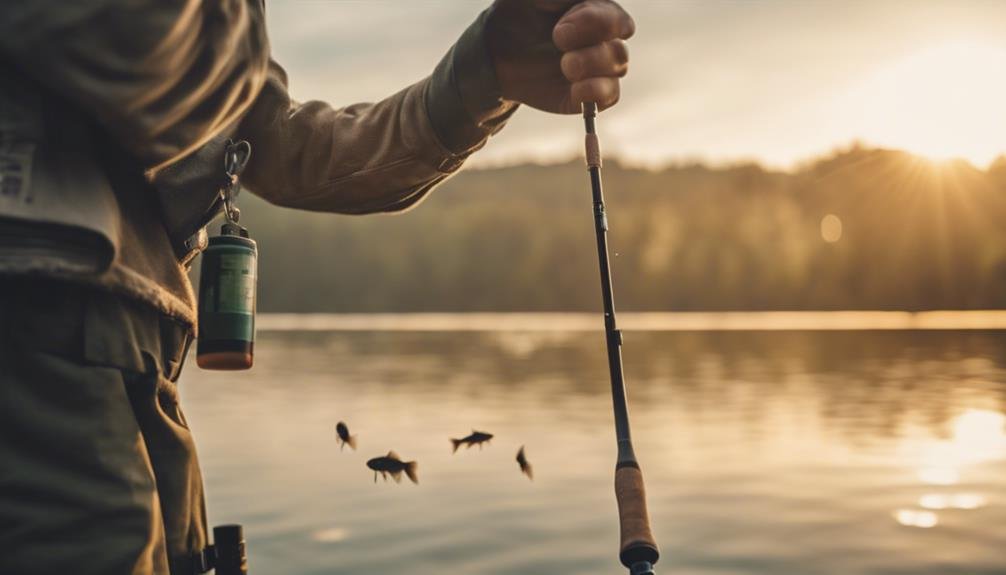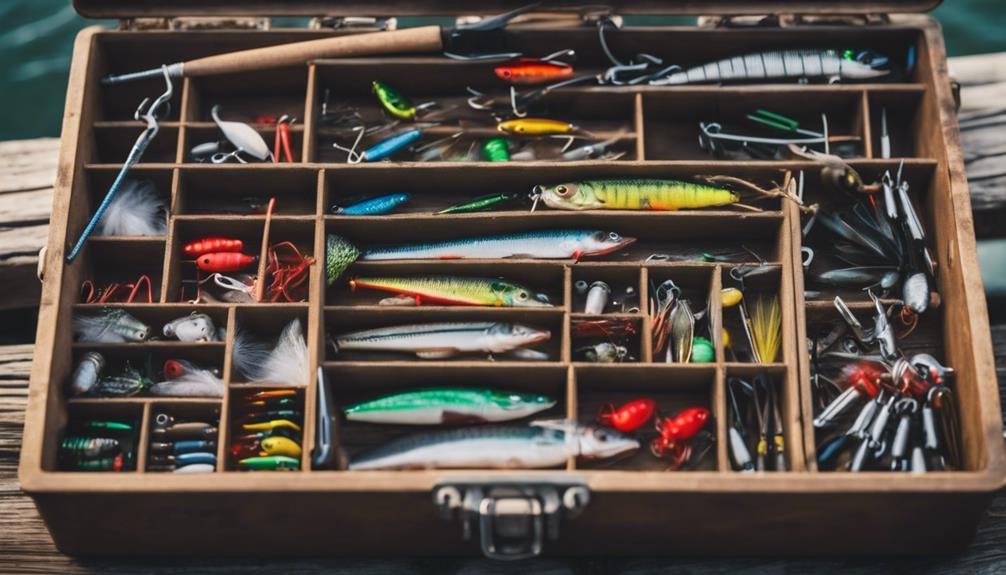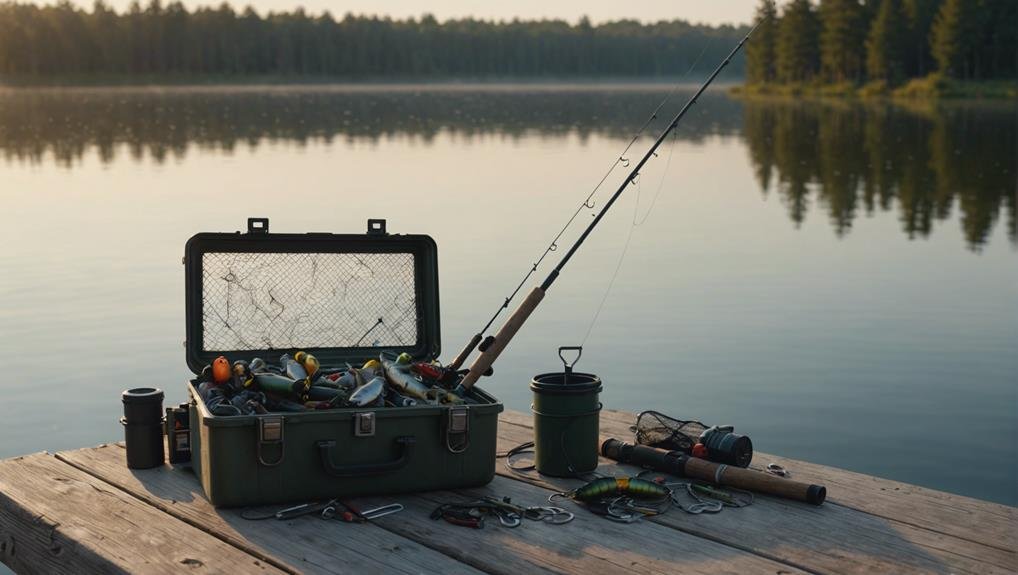When you’re gearing up for a fishing trip, there are a few essentials you can’t afford to overlook. Start with a fishing license if you’re over 16—it’s not just a legal requirement but a mark of responsible angling. Choosing the right rods and reels tailored to your specific needs is important, as is selecting the proper hooks, sinkers, bait, and lures for your target fish species. Don’t forget tools like fishing pliers for managing hooks efficiently. Equipped with these basics, you’re well on your way, but what about the finer details that can make or break your trip?
Key Takeaways
- Obtain a fishing license if you are over 16 to ensure legal and responsible fishing.
- Choose a versatile rod and reel combo based on your fishing needs for an enhanced experience.
- Select hooks and sinkers based on the fish species and desired bait depth.
- Live bait and soft plastics are versatile options for attracting various fish species.
- Carry fishing pliers to manage hooks, cut lines, and safely handle toothy fish.
Fishing License

Before you hit the water, you’ll need a fishing license if you’re over 16. This license is your ticket to enjoying the sport legally and responsibly. Each state has fishing regulations that come with the license, so it’s crucial to familiarize yourself with them.
These regulations include size and bag limits, which specify how many fish you can keep and their minimum size. Adhering to these rules guarantees that fish populations remain sustainable for future generations.
In addition to size and bag limits, your fishing license will outline the permitted fishing methods. This might include what bait and gear you’re allowed to use. For instance, some areas might restrict the use of live bait or certain types of hooks to protect specific fish species.
These rules help maintain a balanced ecosystem and ensure that fishing is enjoyable for everyone.
Rods and Reels
Selecting the appropriate rod and reel is essential for improving your fishing experience and boosting your chances of success. Start with a medium-action spinning combo like the Ugly Stik GX2 paired with a 10-pound monofilament line. This setup offers versatility, making it a great choice for beginners and experienced anglers.
Consider your fishing needs when choosing between spinning, a baitcasting rod, and a reel. Spinning combos are user-friendly and ideal for lighter baits and lures, while baitcasting reels offer greater control and power and are suitable for heavier lures and more challenging catches.
Here are three key factors to keep in mind when selecting a baitcasting reel:
- Gear Ratio: Determines the speed of your reel. Higher ratios retrieve line faster, while lower ratios provide more torque for reeling in larger fish.
- Braking System: Helps prevent backlash and tangles. Magnetic and centrifugal brakes are common types to look for.
- Spool Capacity: Indicates how much line the reel can hold. Match it to the type of fishing you plan to do.
Investing in a versatile rod and reel combo suitable for bait and lure fishing will expand your angling opportunities and enhance your overall fishing experience.
Hooks and Sinkers

Choosing the right hooks and sinkers can greatly enhance your success on the water when gearing up for your fishing adventure. Different hook types, like Aberdeen for panfish and offset shank worm hooks for bass, are important for targeting specific fish species. Picking the right hook size for soft plastics guarantees proper presentation and hooking efficiency, which is essential for a successful catch.
Sinkers play a critical role in controlling bait depth and movement. Utilizing split shot or sliding sinkers helps you fine-tune your setup to attract fish more effectively. Split shots can be easily adjusted on your line, while sliding sinkers offer more flexibility by allowing your bait to move naturally with the current.
Swivels are another essential component in your tackle box. They prevent line twists and enable the creation of advanced rig setups like the Carolina or three-way rig. These rigs can be tailored to different fishing environments and techniques, making them versatile tools for anglers.
Bait and Lures
Choosing the right bait and lures can make or break your fishing trip, as different options cater to varying fish species and conditions. When getting started, understanding the basics of live bait, soft plastics, and other lures is essential.
Live bait, like nightcrawlers, is a universal option for freshwater fishing and can attract various species. Soft plastics provide versatility and mimic the movement of real prey, making them a go-to choice for many anglers.
When assembling your fishing tackle, consider these three essential elements:
- Live Bait: Nightcrawlers and minnows are effective for many fish. They offer a natural and enticing option that’s hard for fish to resist.
- Soft Plastics: These lures come in various shapes and colors, designed to mimic worms, grubs, and other prey. They’re great for experimenting with different retrieve speeds and depths.
- Spinnerbaits and Topwater Lures add variety and excitement to your fishing trip. Spinnerbaits work well in murky waters, while topwater lures are perfect for surface-feeding fish.
Additional Tools

Every angler needs dependable fishing pliers to manage hooks and tackle efficiently. Fishing pliers, such as the Googan Squad Split Ring Pliers, are essential tools that allow you to remove hooks safely from fish without causing injury.
Needlenose pliers become a must-have tool when dealing with toothy critters, providing the extra reach and precision you need.
It is essential to keep a pair of pliers handy during fishing trips. They significantly handle your angling gear, making tasks like cutting lines, crimping split shots, and adjusting lures much easier. Quality fishing pliers are designed to withstand the rigors of the fishing environment and deliver reliable performance every time.
Efficiently managing your fishing tackle is key to a successful outing, and having the right tools, like fishing pliers, ensures you’re prepared for any situation.
Safe hook removal is important for both the fish’s well-being and your safety. So, whether you’re a seasoned pro or a novice angler, investing in a good pair of fishing and needle nose pliers is wise for any fishing enthusiast.
Conclusion
By ensuring you have a fishing license, the right rods and reels, appropriate hooks and sinkers, and carefully chosen bait and lures, you’re setting yourself up for a successful fishing adventure.
Don’t forget those extra tools like fishing pliers to make your trip smoother.
Equipped with these essentials, you’ll enhance your chances of catching fish and enjoying a sustainable and rewarding time on the water.
Happy fishing!
FAQs
What are the essential tools and gear for fishing?
Essential fishing tools and gear include:
- Fishing Rod and Reel: These basic tools for casting and retrieving your bait or lure.
- Fishing Line: There are various types of fishing lines, such as monofilament, fluorocarbon, and braided lines, for different fishing conditions.
- Hooks: Various sizes and types of hooks suitable for different fish species.
- Bait and Lures: Live bait, artificial lures, or a combination to attract fish.
- Tackle Box: To organize and store your fishing gear, including hooks, lures, and lines.
- Pliers: For removing hooks, cutting lines, and making adjustments.
- Fishing Net: To safely land your catch without harming the fish or your gear.
- Tackle: Includes weights, swivels, floats, and leaders for setting up your fishing rig.
- Fishing License: Required in most areas to fish legally, ensuring adherence to local regulations.
Why is a good tackle box important for fishing?
A good tackle box is important because it:
- Organization: Keeps your fishing gear organized and easily accessible.
- Protection: Protects hooks, lures, and other accessories from damage.
- Convenience: It makes transporting your gear to and from your fishing location easier.
- Efficiency: Saves time by quickly finding and using the tools and tackle you need.
What types of fishing lines should I consider?
There are three main types of fishing lines to consider:
- Monofilament Line: Versatile and affordable, suitable for various fishing conditions. It has good knot strength and some stretch, making it ideal for beginners.
- Fluorocarbon Line: Virtually invisible underwater, making it perfect for clear water and wary fish. It is also more abrasion-resistant than monofilament.
- Braided Line: This line is extremely strong and has no stretch, making it ideal for heavy cover and deep water fishing. Its smaller diameter, for its strength, allows for longer casts and better sensitivity.
What are some common baits and lures used in fishing?
Common baits and lures include:
- Live Bait: These include worms, minnows, and crickets, which are effective for many fish species.
- Soft Plastics: Worms, grubs, and creature baits made from soft plastics that mimic natural prey.
- Crankbaits: Hard lures that mimic the movement of small fish, effective for covering large areas and varying depths.
- Spinnerbaits: Lures with spinning blades that create flash and vibration, attracting fish in murky water.
- Topwater Lures: Poppers, frogs, and buzz baits that create surface commotion to trigger aggressive strikes from fish.
How do I choose the right fishing rod and reel?
Choosing the right fishing rod and reel involves considering the following:
- Type of Fishing: Determine whether you will be fishing in freshwater or saltwater and whether you are targeting specific species.
- Rod Action: Fast-action rods are more sensitive and suitable for single-hook baits, while slow-action rods are more flexible and better for multi-hook lures.
- Rod Length: Shorter rods offer better control, while longer rods allow longer casts.
- Reel Type: Spinning reels are versatile and easy to use, baitcasting reels offer better accuracy for experienced anglers, and fly reels are specific for fly fishing.
- Power: The rod’s power (ultra-light to heavy) should match the weight of the line and lures you plan to use.
What safety gear should I bring on a fishing trip?
Essential safety gear for a fishing trip includes:
- Life Jacket: This is especially important if fishing from a boat or in deep water.
- First Aid Kit: To handle minor injuries, such as cuts or hook punctures.
- Sun Protection: Sunscreen, hats, and sunglasses to protect against harmful UV rays.
- Weather Gear: Appropriate clothing and rain gear to stay dry and comfortable.
- Communication Device: A mobile phone or radio to call for help in an emergency.
- Knife: A sharp knife for cutting lines, preparing bait, and other uses.
Understanding and having the essential fishing gear can greatly enhance your fishing experience, making it more enjoyable, successful, and safe.

